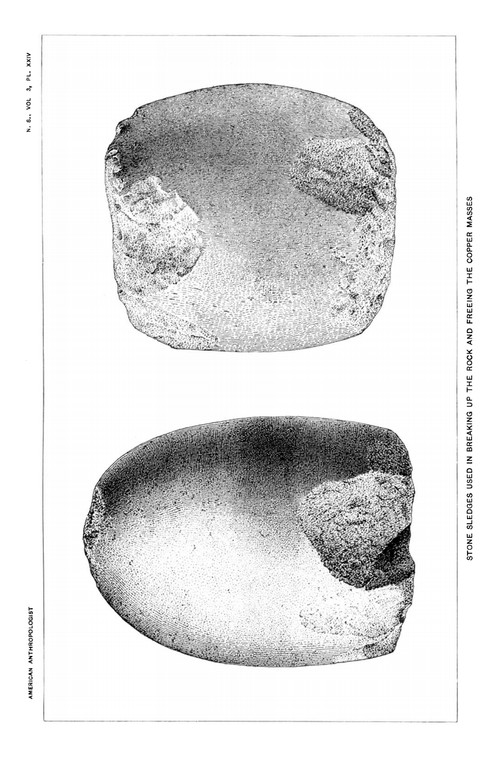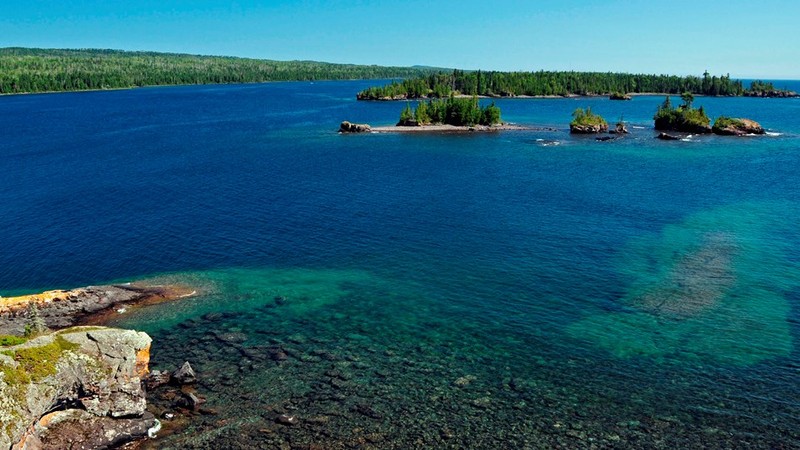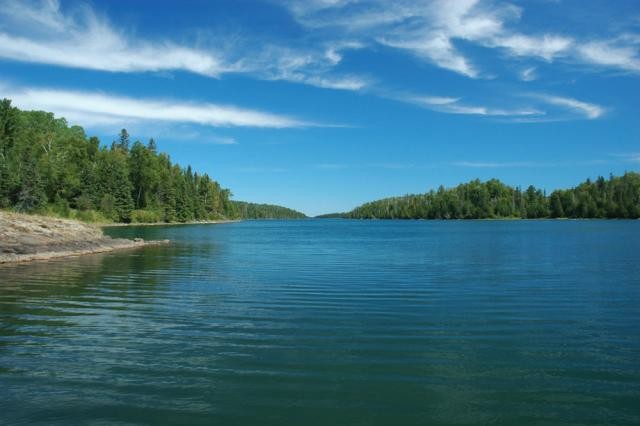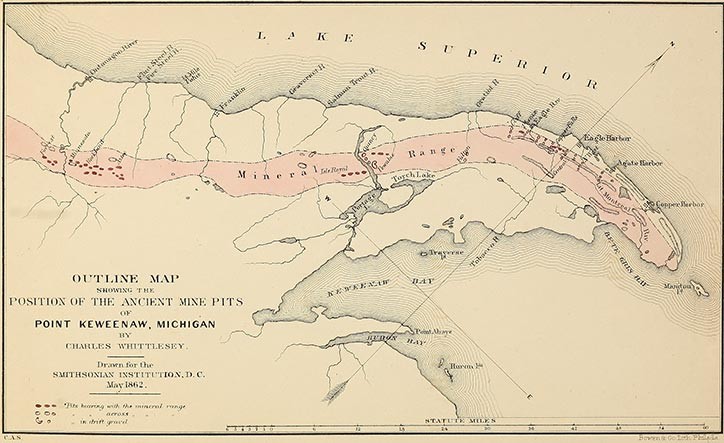Native American Copper Mining Pits at Isle Royale
Introduction
Text-to-speech Audio
Isle Royale is the location of the extensive mining for copper that took place by Natives living in the Great Lakes Region. Copper mining first started as early as between 6000 B.C. to 500 B.C. by the people of the Old Copper Culture. As time passed, different Native American groups continued to mine for copper well into historic times.
Images
Beach stones used to remove copper from enclosing rock

Isle Royale

McCargoe Cove

Historic map of ancient copper mine pits, in http://scienceviews.com/ebooks/ancient_mining/, accessed 05/07/2017.

Backstory and Context
Text-to-speech Audio
History of Copper Mining on Isle Royale
Among the earliest people to visit Isle Royale were those from what is known as the Old Copper Culture (2). This occurred during the time period of between 6000 B.C. to 500 B.C. The Old Copper Indians were some of the first people to manufacture metal in North America. Copper was abundant at Isle Royale, and those of the Old Copper Culture were the first Indians to discover these deposits of copper and exploit them.2 The Old Copper Indians were succeeded by Native American groups from the Early Woodland period, who continued to mine for the copper at Isle Royale.2 The Woodland Indians that lived in this region near Lake Superior had a steady demand for copper from neighboring Woodland tribes. The mining and trading of copper continued into the late 1500s and early 1600s. The mining of copper on Lake Superior came to an end just prior to the coming of the Europeans to the region.
Copper Mining Process
Deposits of copper were located by exploring the surface (1). They would remove the copper from the rock by using large, long stones found along the beach, as hammers (1). Some copper mining sites were worked by the Indians over a period of several generations (2). Some pits reached twenty feet into the ground.2 The creation of these deeper pits required hundreds of the hammer stones, that would then be discarded near or within the pit (2). The Indians used birch bark buckets to carry rocks out of the pit (2). The deeper pits were known to contain very large pieces of copper that could weigh up to thousands of pounds.2 They would try to reduce the size of these massive pieces, leaving them behind if they were unsuccessful in doing so (2).
Copper Mining Pits on Isle Royale
Extensive mining took place on Isle Royale.2 Several shallow mining pits can be seen along Stoll Trail, where hikers pass directly over these pits.2 However, it is at McCargoe Cove, at Isle Royale, that archaeologists have discovered 1025 mine pits.2 Most of the mines discovered were shallow pits where copper was easily extracted.2 Among the discoveries at McCargoe Cove, the fissure mines were quite impressive.2 Fissure mines comprised of narrow shafts that lead along the veins of copper between partings in the rock.2 The natural partings in the rock were widened by the Indians and extended downward.2 An average fissure mine, at McCargoe Cove, was a few feet wide at the surface and about ten feet long and ten feet deep.2 It is estimated that the Indians would remove about two hundred cubic feet of rock from one of these fissure mines, using the beach stones and birch bark baskets.2 Lode mines were even larger than fissure mines.2 The average lode mine at, McCargoe Cove, was about twelve feet deep and required the removal of two thousand cubic feet of rock.2 This rock was discarded on the sides of the pit, which may have caused the concealment of even earlier lode mines.2
Among the earliest people to visit Isle Royale were those from what is known as the Old Copper Culture (2). This occurred during the time period of between 6000 B.C. to 500 B.C. The Old Copper Indians were some of the first people to manufacture metal in North America. Copper was abundant at Isle Royale, and those of the Old Copper Culture were the first Indians to discover these deposits of copper and exploit them.2 The Old Copper Indians were succeeded by Native American groups from the Early Woodland period, who continued to mine for the copper at Isle Royale.2 The Woodland Indians that lived in this region near Lake Superior had a steady demand for copper from neighboring Woodland tribes. The mining and trading of copper continued into the late 1500s and early 1600s. The mining of copper on Lake Superior came to an end just prior to the coming of the Europeans to the region.
Copper Mining Process
Deposits of copper were located by exploring the surface (1). They would remove the copper from the rock by using large, long stones found along the beach, as hammers (1). Some copper mining sites were worked by the Indians over a period of several generations (2). Some pits reached twenty feet into the ground.2 The creation of these deeper pits required hundreds of the hammer stones, that would then be discarded near or within the pit (2). The Indians used birch bark buckets to carry rocks out of the pit (2). The deeper pits were known to contain very large pieces of copper that could weigh up to thousands of pounds.2 They would try to reduce the size of these massive pieces, leaving them behind if they were unsuccessful in doing so (2).
Copper Mining Pits on Isle Royale
Extensive mining took place on Isle Royale.2 Several shallow mining pits can be seen along Stoll Trail, where hikers pass directly over these pits.2 However, it is at McCargoe Cove, at Isle Royale, that archaeologists have discovered 1025 mine pits.2 Most of the mines discovered were shallow pits where copper was easily extracted.2 Among the discoveries at McCargoe Cove, the fissure mines were quite impressive.2 Fissure mines comprised of narrow shafts that lead along the veins of copper between partings in the rock.2 The natural partings in the rock were widened by the Indians and extended downward.2 An average fissure mine, at McCargoe Cove, was a few feet wide at the surface and about ten feet long and ten feet deep.2 It is estimated that the Indians would remove about two hundred cubic feet of rock from one of these fissure mines, using the beach stones and birch bark baskets.2 Lode mines were even larger than fissure mines.2 The average lode mine at, McCargoe Cove, was about twelve feet deep and required the removal of two thousand cubic feet of rock.2 This rock was discarded on the sides of the pit, which may have caused the concealment of even earlier lode mines.2
Sources
1 Holmes, William H. "Aboriginal Copper Mines of Isle Royale, Lake Superior." American
Anthropologist, New Series, 3, no. 4 (1901): 684-96. http://www.jstor.org/stable/659088.Peters, Bernard C. "Wa-bish-kee-pe-nas and the Chippewa Reverence for Copper." Michigan Historical Review 15, no. 2 (1989): 47-60. doi:10.2307/20173182.
2 Karamanski, Theodore J. "Narrative History of Isle Royale National Park." , 6-20. Published 1988.
Anthropologist, New Series, 3, no. 4 (1901): 684-96. http://www.jstor.org/stable/659088.Peters, Bernard C. "Wa-bish-kee-pe-nas and the Chippewa Reverence for Copper." Michigan Historical Review 15, no. 2 (1989): 47-60. doi:10.2307/20173182.
2 Karamanski, Theodore J. "Narrative History of Isle Royale National Park." , 6-20. Published 1988.
